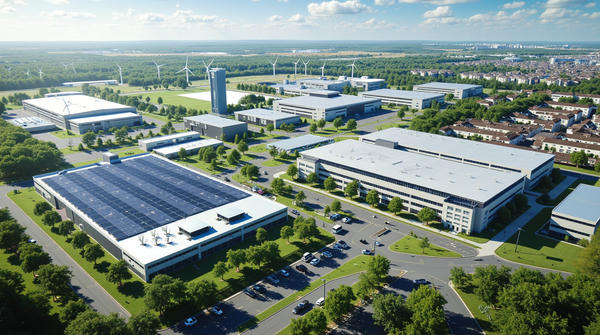The 5 Energy Innovations that Will Change Our Daily Lives by 2027

Sustainable energy: a challenge, but also an opportunity 🌍
How about rethinking the way we consume energy? In the face of climate challenges and volatile energy prices, the question of our energy transition has never been more pressing. Discussions around sustainable energy are giving rise to passionate debate. How can we combine emissions reduction, energy independence and social equity? Are current solutions up to the challenge?
The weight of energy uncertainty
The European Union, heavily dependent on energy imports, is feeling the effects of international crises. According to Eurostat, nearly 58% of our energy comes from abroad. This dependence creates vulnerability to fluctuations in world markets. At the same time, dynamic energy prices, which vary according to supply and demand, are perceived as both a constraint and an opportunity to encourage consumers to adjust their habits.
But let's be clear: imposing price increases without concrete alternatives for households is a dead end. This is where innovation comes in. By making the most of energy flexibility, we can turn this uncertainty into a lever for adaptation.
Energy flexibility: an underestimated lever ⚡
For example, heat pumps and domestic batteries are already helping to reduce energy demand at peak times. In several European countries, financial incentives encourage the purchase of such equipment. In Germany, homes equipped with solar batteries can sell their surplus electricity back to the grid, creating a virtuous circle.
Electric vehicles also play a key role. Did you know that an electric car, connected to a smart grid, can store energy at night (when electricity is cheaper) and return it to the grid during the day? This concept, known as "vehicle-to-grid", is being tested in the Netherlands with promising results.
Energy communities: a collaborative solution 🤝
Faced with the growing saturation of traditional electricity grids, energy communities are emerging as an innovative solution. These groupings of citizens, businesses and local authorities make it possible to collectively manage energy production and consumption on a local scale.
The problem is well known: peak solar power production can sometimes exceed the absorption capacity of the grid, leading to negative prices and forced disconnections of installations. In Germany, for example, these situations have become more frequent, with over 200 hours of negative prices in 2023.
Energy communities provide a local response to this challenge. By pooling resources and sharing the energy produced, they optimize collective self-consumption. For example, when a school's solar panels produce power at the weekend, the energy can be used by local businesses or residents, thus avoiding grid congestion.
Pilot projects in Europe are showing promising results. In Loenen in the Netherlands, an energy community is using a shared battery to store excess solar energy, reducing peak feed-in to the grid by 90%. In France, the COMPILE project in Luzy demonstrates how a small town can become energy self-sufficient by intelligently managing energy flows between neighbors.
Hydrogen: a revolution on the way 💧
Let's talk about another solution for the future: hydrogen. This gas, when produced from renewable sources, could become a pillar of our energy transition. In Spain, an ambitious project aims to create a "green hydrogen corridor" linking several European countries. This corridor could supply heavy industries and drastically reduce their emissions.
Admittedly, hydrogen is still expensive to produce today. But with strategic investment (like the 5.4 billion euros the European Union plans to allocate between now and 2030), it could become competitive. Imagine the opportunities: clean trains, carbon-neutral factories, homes heated with green energy...
The 5 Major Innovations That Will Transform Our Energy Landscape
1. Smart Grids 🔌
Smart grids represent a revolution in energy management. Equipped with sensors and artificial intelligence, these networks will automatically optimize electricity distribution according to actual demand. Demand Response" (or diffuse load shedding) enables consumers to reduce or shift their electricity consumption during peak periods, in exchange for financial compensation. For example, a manufacturer may agree to temporarily reduce its production, or a private individual may allow his water heater to shut down briefly. In France, RTE estimates that this flexibility could represent up to 6.5 GW of shaving capacity by 2027. Combined with this approach, smart grids will enable energy losses to be reduced by 30% and renewable energies to be integrated more effectively.
2. New Generation Energy Storage 🔋
Solid-state batteries and supercapacitors promise greater energy autonomy. These technologies, which are safer and more durable than current lithium-ion batteries, will offer up to three times greater storage capacity. Homeowners will be able to store solar energy more efficiently, significantly reducing their dependence on the grid.
3. Accessible Green Hydrogen 💧
Thanks to technological advances and economies of scale, the cost of producing green hydrogen is set to fall by 60% by 2027. This will enable its widespread deployment in public transport and industry, offering a clean alternative to fossil fuels.
4. Biosourced buildings 🌱
By 2027, bio-sourced building materials will revolutionize the way we design buildings. This technology, which uses natural materials such as hemp, wood and straw, makes it possible to create buildings with a negative carbon footprint that store more CO2 than they emit. The first fully bio-sourced neighborhoods will demonstrate the viability of this ecological solution.
5. Innovative thermoelectric materials 🌡️
New materials capable of converting heat directly into electricity will transform energy recovery. These innovations will make it possible to recover waste heat from industry and buildings, creating an additional source of energy from what was previously wasted. The first large-scale deployments are scheduled for 2026.
These innovations are not simply technological evolutions, but real breakthroughs that will redefine our relationship with energy. Their gradual deployment between now and 2027 will create a cleaner, more efficient and more resilient energy system.
And what about tomorrow?
The energy transition also depends on us. As citizens, we have a role to play. We can adapt our habits, invest in sustainable solutions and support ambitious policies. For example, have you thought about optimizing your consumption during off-peak hours? Or taking part in local energy production programs?
In conclusion, the challenge of sustainable energy is immense, but solutions do exist. The European Union, with its pioneering projects, is leading the way. What about you? What do you think would be the most effective ways of speeding up this transition? I'd be delighted to hear your views! 💡



